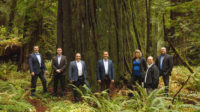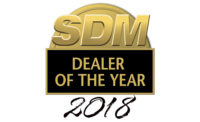A ‘Three-Peat’ Coach
Tim Whall has been at the head of three different SDM Dealer of the Year-winning companies, first for HSM in 2005 and again for P1 in 2012. (Read the Protection 1 Dealer of the Year story.)
What is his secret for success?
“What keeps Tim coming back to this list? The people,” says Jamie Haenggi. “He has created a really close management team that enjoys working together because his passion is really about coaching. He enables us to bring out the best in ourselves, our team and our frontline employees. He is one of the most gifted coaches out there.”
Jim DeVries concurs, adding, “Tim’s three-peat is about his coaching and his approach to leadership and customer centricity, but mostly about the system he has created. The GM model is one ingredient, but so are our incentives and culture of taking care of the customer and so is our scale and so is technology. It is really a system that orbits around the customer and about deploying that playbook, how we keep score, the metrics and how we look at it. There are probably a dozen different components that all deployed together help us to be a better, more customer-friendly environment.”
For his part, Whall is enjoying the challenge and opportunity of “coaching” a company on this scale. “It’s kind of cool to be the big guy on the block and seeing how you can bring small town ideas to a big company.” It is both a challenge and an opportunity, Whall says. “It is a lot easier if I have 100 technicians in my pool than if I have two. I have been small, medium and big. When I am small any one little thing can put me off the rail. The more scale you have, the easier it is to deliver that same concept. When you have more resources to do the task at hand it is easier to manage the task at hand.”
One thing that has helped him this time around is that ADT, which had gone public in 2012, was taken private with this venture, allowing Whall and his team more freedom to bring new ideas and make necessary changes. “Regardless of being a private or public company, we make decisions that are good for the business in the long term. This is a 143-year-old company — short-term decisions do not serve customers, employees and other stakeholders in a way that enhances value over time.”
DeVries is excited by the results so far. “A long time ago there was a term in vogue called ‘boundary-less organizations’ and I would say that is how Tim leads our organization. I don’t think of myself as an operating executive. I don’t think of our CFO as just the financial guy. Jamie is involved in far more than just the marketing and sales. The way this team operates is like nothing I have ever experienced before. It is one unified team.”
Industry Leader
ADT is often referred to as the 800-pound Gorilla in the industry, but how do they feel about that appellation? Turns out they are pretty proud of their status. But with that pride also comes a strong sense of responsibility.
“I think everybody in the market wants ADT to do well,” Whall says. “It is good for the industry when the leader is doing well.”
Haenggi sees the heavyweight status as a duty to the security industry, something ADT has long used to bring its influence to bear on issues such as deceptive sales practices, for example. “Because we have the size and resources and influence, we take a deep sense of responsibility, not only for our customers, but for the industry to make sure we maintain proper practices favorable to our industry.”
ADT was one of the first to bring the issue of deceptive door knockers to light several years ago. “People were leveraging the familiarity of the ADT name to get in homes,” she says. When ADT started bringing lawsuits and working with organizations such as the Electronic Security Association and The Monitoring Association (formerly CSAA) to educate consumers about deceptive sales in the industry, things started to turn around, and as a result there are fewer of those incidents today, Haenggi says. “All 14,000 competitors enjoy knocking on doors. It is a legitimate business process and we wanted to be sure there was fairness and integrity for all.”
With the P1 merger also came Don Young, who brought another level of industry participation to ADT. Young started Partnership for Priority Verified Alarm Response (PPVAR) years ago and was the organization’s first president. He is also the current vice president and incoming president of TMA.
At Young’s direction, ADT joined the ASAP to PSAP program in 2016, and is also getting more active with organization leadership. In addition to Young at TMA, Thomas Nakatani, vice president IT, customer monitoring technologies, will take over as president of PPVAR in the fall of 2018.
“ADT didn’t do things like support ASAP to PSAP or the Five Diamond program before,” Young says, relating this back to the cultural change that has occurred in the past 18 months. Having worked at ADT once before from 2001 to 2004, he has a vantage point to compare. “When you worked for ADT before it was almost like a different world than if you didn’t back then. It is the difference between being active in the industry versus believing you are the industry.
“Now having had that exposure outside of ADT, it was helpful to us to be able to bring back to ADT that mindset that in my view they never had. It doesn’t mean they didn’t care about industry initiatives, but it was more out of self-interest. Now we are making executive decisions and causing a big culture shift. We want to earn the brand and not have it be a popularity or size contest.”
Brand Love
No one would dispute that ADT has strong branding and marketing. In fact, many competitors explicitly credit ADT’s extensive marketing with also helping their efforts, particularly in getting the word out about new technologies and services.
But maintaining and moving forward a brand so embedded in the national consciousness comes with its own unique challenges. Jamie Haenggi came over from P1 and was tasked to do just that. One of her signature campaigns has been the “Brand Love” program, which uses social media platforms to “listen” for conversations related to the ADT brand and product and randomly “surprise” customers with personalized notes and small tokens of appreciation.
“We have a whole team of people that just manage the social presence,” Haenggi says. But she acknowledges that not all of the impressions are positive. “We love the positive interactions, but for customers that use social media to say negative things we also want to jump on that and take care of it as soon as possible.”
As they do on the customer calls, ADT is using technology on the social media side to make sure these responses are personalized and not cut-and-paste, she adds. “We don’t want corporate speak,” Haenggi says. “We try to connect one on one with people having these issues. Recently one of our product marketing leaders got on the phone with a customer at 8 at night and worked with them to recreate the issue they were having so we could fix it.”
They are also able to tailor different social media messages to customers and potential customers or by geography, she says. “For example, when the hurricane happened we were able to target customers in those affected markets with specific information around safety and how to manage alarm systems during a hurricane.”
These efforts seem to be working. Not only has ADT increased its social community by 32.6 percent in the past year and a half, but Haenggi reports that employees are taking note in different markets. “Whenever I travel employees will say, ‘We see the advertising, but what is really cool is my wife was in yoga class the other day and some twenty-something came up to her and said they love the new advertising.’”
One of the most recent branding changes involved the ADT logo. While it wasn’t complex to begin with, the leadership team decided to simplify it even further, taking away the box around the letters and the outline around the outside. “It is a way to update and refresh the look,” Haenggi says. “The blue octagon is iconic and this allows it to stand out clearly and the letters to be the focus. Simplicity speaks to the boldness of the brand.”
‘People Protecting People’
Along with the new mantra of customers first, ADT has another tagline it is particularly proud of — people protecting people. Getting the employees on board with the more customer-centric approach wasn’t hard; but along with the desire to do it, there was also a shift in hiring, training, mentoring and motivating.
“If I were to try to summarize what we are seeking from our employees in two words it would be discretionary effort, going the extra mile,” says Jim DeVries. “From my perspective one of the most interesting things about this service transformation is that it has occurred in many cases with the same number or even fewer employees.”
That is in part due to the vast network of technology supporting the effort. But the other part of that equation is the people part. From the start, ADT looks to hire based on criteria that goes beyond (and sometimes instead of) industry experience, says Amelia Pulliam, chief human resource officer. “We have expanded our internal recruitment organization,” she says. “In the past it was fully outsourced. We have been focused over the last year on expanding our ability to have in-house people helping with recruitment. We are also leveraging the good work our marketing is doing telling the ADT story and the history and richness that we have…. Our presence on social media continues to amplify our relevance, and is a huge part of how we are able to attract talent. I can’t underscore enough the value of what purpose does an organization have. What is our cause? Why are we here? We save lives. That is a cause that resonates well with our millennial workforce.”
Another thing that resonates with younger employees is technology, she adds. “The decisions we have made around the expansion of technology and the smart home are also attracting a generational workforce that values having the ability to work on things like that. It is cool, more than just a typical alarm company.”
The company also has introduced new assessment tools, especially with the call centers to screen candidates that will be able to provide that best experience, Pulliam adds. “Our belief is we need to look for people that understand customer service and providing exceptional service regardless of the role you play. We want employees who do it not just because we are paying them to, but because it matters. We have had great success with former real estate, hospitality and retail employees. The core piece is how you connect with the customer whether in person or over the phone. You can teach someone the product side of the business, but it is harder to teach the service mentality.”
Once hired, ADT is committed to both traditional and non-traditional training methods. In addition to the typical onboarding process of classroom training, the company also incorporated virtual training that allows employees from all over the country to participate, fostering a community sense that they are part of something bigger, says Jamie Haenggi.
“This has shifted almost entirely the way we were doing training before, which was in the classroom,” Pulliam adds. “Now much of it is done virtually but it is a much more engaging experience…. We are constantly looking at how we are doing the training to make it as fresh as we can for the people receiving it.”
The company also has instituted a pilot mentoring program for its sales employees, which Pulliam plans to expand to more employees. “We always used the term ‘mentoring’ but it was a more informal approach. This is something individuals can use and some best practices that can be done enterprise-wide.” Mentoring will be done on a national front, with mentor and mentee not necessarily in the same office, she adds. “We want to have cross-borders and cross-pollination as much as possible, as a way to create the biggest impact. There is a power in understanding that my issues in Toronto aren’t that different from someone’s in Knoxville. It helps to know someone else is going through the same thing.”
The final piece is keeping current employees motivated by the higher purpose of saving lives. One way the company has done that for the past several years is through its popular LifeSaver award program, says Bob Tucker, public relations director. This program takes Tucker and his team all over North America bringing together the call center dispatcher and first responders with the ADT customers they’ve helped. The ADT employee is flown to the customer’s home for an emotional reunion and presented with a LifeSaver Award, the company’s highest honor. The local police, EMT and fire departments are given checks. (See page 36 of this issue to read about the most recent LifeSaver Award, presented in New York on October 26.)
Wanting to share that feeling of success, Tucker instituted a new idea last year called “Inspiration Stations” in all of ADT’s monitoring centers, key sales locations and the main lobby at the company headquarters in Boca Raton, Fla. “We take the LifeSaver videos, which we produce every other week and put them on a touchscreen. The idea is during breaks or before or after shifts, if an employee wants to be inspired about the job they do, they can watch one of these videos.” The mobile stations also can be used for meetings, job orientation and training, he says.
All of these efforts have paid off in employee satisfaction and retention rates, Pulliam says. “Voluntary employee attrition is down from 40 percent to 30 percent since January as a total organization, which is a huge shift. Every single group is down. There are a host of reasons, but those are real results. When we see employees sticking and staying year over year, something is working.”
Empirically, employees have shared with Pulliam some of the reasons they are happier. “I have heard from many of them personally that some of the process improvements we have put in place help them do their jobs better. We added staff where we needed to. Now they are enjoying the work and have started to feel ‘I can do this job.’”
Tucker points to the customer-first approach as being one of the biggest factors, as happy customers make happy employees. “Who wants to sit in a call center and get yelled at? There is a direct correlation between great customer service and keeping employees longer.”
















